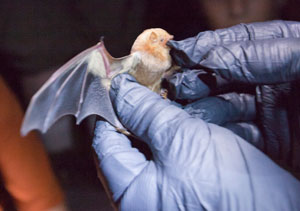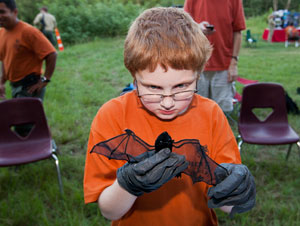Bat Boys
You have seen the scary shows and you have heard the scary stories, but none of them are true. Bottom line: Bats get a bad rap.
 |
| An eastern red bat nibbles on the finger of an adult bat expert. |
Cub Scout Pack 234 from Olive Branch, Miss., learned that at a Scouting For Bats event last summer at Sardis Lake in north Mississippi.
The Cub Scouts found out that bats do not like to bite people, they hardly ever spread disease … and some of them are actually kind of cool to look at, like the live eastern red bat that the boys got to see up close.
And when it comes to doing good deeds, bats are some of the most helpful creatures in the animal kingdom. They eat tons and tons of bugs — including lots of blood-sucking mosquitoes — and they help spread plant seeds and pollinate other plants.
Even their poop, or guano, is useful. It is a very effective fertilizer for gardens.
“I used to think they were kind of creepy,” says 10-year-old Charlie Williams.
“Well, I don’t think they’re creepy anymore.”
Protecting Bats
 |
| Graham Fargo examines a bat replica up close. |
The Scouting For Bats event was hosted by the Mississippi Bat Working Group, volunteers who share a common interest in the protection of bats. Nearly half of the bat species that live in our country are endangered or in severe decline.
“People are destroying their habitat and they don’t have anywhere to live,” says 11-year-old Noah Womack.
Some bats live in caves, others live in trees and still others under bridges. Construction projects and plain carelessness can destroy large groups of bats at a time.
Fewer bats means big trouble for people everywhere.
“If we didn’t have bats,” says 10-year-old Tucker Bobbitt, “the bug population would be way too high.”
Closer Examination
 |
| Andrew Braddock feels his way through the echo-location exercise. |
The Cub Scouts spent time at five stations learning about bat habitat and conservation, and took a bat quiz to learn how bats adapt to their environment.
They learned how scientists use devices called mist nets to gently capture bats, examine them, then release them back into the wild unharmed.
One of the volunteers caught a young eastern red bat, one species of microbat found in north Mississippi.
“It looked like a tiny lion with wings,” Charlie says. “It flapped its wings, and I could feel the air on my face.”
The bat was inspected, measured and weighed, then released back into the wild so it could eat more bugs. The Cub Scouts went home with a new appreciation for their winged friends.
“They’re really good for the environment,” Noah says. “They’re so much cooler than I thought they were.”
They are SSSOOOOOO cool!!!!